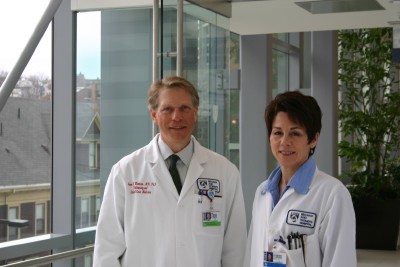Multidisciplinary Pulmonary Vascular Disease Program Established

Aaron Waxman and Barbara Cockrill
The new, multidisciplinary BWH Pulmonary Vascular Disease Program aims to promptly evaluate, and treat patients with complex pulmonary vascular problems including pulmonary arterial hypertension. The program includes a diverse research program and provides access to dozens of clinical trials. A major focus is on the evaluation of patients with unexplained shortness of breath, which is often attributed to pulmonary hypertension (PH).
The program is directed by Aaron Waxman, MD, PhD, who recently joined BWH from MGH, where he and colleagues had built up the largest program of this kind in Boston. He and his colleague, Barbara Cockrill, MD, bring many of their 500 patients to BWH, and access to cutting edge clinical trials and research into the causes of PH.
“What’s been done at the Brigham previously for PH has been focused primarily in PAH and congenital heart disease,” Waxman said. “But PH encompasses a much broader group of patients.”
About 30 percent of patients with unexplained shortness of breath have PH, he said. And patients with other diseases, including heart disease, COPD, chronic thromboembolic disease, HIV and advanced liver disease may develop secondary PH over time and benefit from treatments.
“Our goal is to build a broad pulmonary vascular disease program in collaboration with members of the Cardiovascular Medicine division and the Boston Adult Congenital Heart (BACH) Service,” he said, adding that the expertise of both cardiovascular and pulmonary physicians is critical in diagnosing and treating PH and other conditions that cause shortness of breath.
The Pulmonary Vascular Disease Program includes members of (BACH) Service, led by Michael Landzberg, MD, in providing expertise and advanced therapeutic options for patients with congenital heart disease. The Pulmonary Vascular Disease Program will also collaborate with Samuel Goldhaber, MD, and the BWH Venous Thromboembolism Research Group.
“The development of a collaborative pulmonary vascular service represents a welcome recognition of the need for change in the way a complex and relatively rare condition is investigated and managed in response to therapeutic breakthroughs,” said Anne Fuhlbrigge, MD, clinical director of the Pulmonary and Critical Care Medicine division.
The program’s team includes pulmonary and cardiovascular physicians, clinical nurse specialists, pharmacists and social workers. Together, the team works to expedite diagnostic work-up and develop a plan of care individualized to each patient’s needs, providing diagnostic evaluation, treatment and long-term follow-up for patients with pulmonary vascular disease.
Waxman brought to BWH 22 active clinical trials, both investigator- and industry-initiated, and said that additional trials were in the works. These trials are testing six to seven new classes of drugs that could benefit PH patients; currently there are only three FDA-approved classes of drugs for PH.
“Over the last decade, the development of oral therapies has made a huge difference for patients,” Fuhlbrigge said. “We see far fewer patients for transplant because these therapies are so effective.”
For those patients who do still require a transplant, program staff plan to work closely with both heart and lung transplant teams.
Waxman also hopes to collaborate with staff who care for patients with gastrointestinal conditions and liver disease, as well as rheumatologists, whose patients make up one of the largest subsets of people who develop PH. “We’re eager to work with them and take care of the pulmonary side of things,” he said.
Both Cockrill and Waxman plan to work closely with the Connors Center for Women’s Health and Gender Biology. “Women and men with PH present differently,” Waxman said. “And PH affects about four women for every man.”